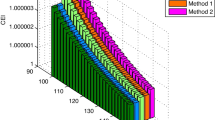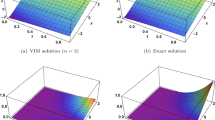Abstract
In previous works (Dimov and Maire in Adv Comput Math 45(3):1499–1519, 2019; Dimov et al. in Appl Math Model 39(15):4494–4510, https://doi.org/10.1016/j.apm.2014.12.018, 2015), we have developed two Monte Carlo algorithms to solve linear systems and Fredholm integral equations of the second kind. These algorithms rely on the computation of a score along a discrete or continuous homogeneous Markov chain until absorption. Here, we propose two approaches to extend the Fredholm algorithm to Volterra equations. The first one is based on a change in variable at each step of the Markov chain. The second one uses the indicator function to transform the Volterra equation into an appropriate form. The resulting Markov chains are inhomogeneous with an increasing absorption rate. The convergence is ensured as soon as the Volterra kernel is bounded. Numerical examples are given on basic reference problems and on high dimensional test cases up to 100 dimensions.
Similar content being viewed by others
Explore related subjects
Discover the latest articles, news and stories from top researchers in related subjects.References
Abdou MA, Badr AA, Soliman MB (2011) On a method for solving a two-dimensional nonlinear integral equation of the second kind. J Comput Appl Math 235:3589–3598
Al-jarrah Y, Shatnawi TAM (2019) Sinc method for two-dimensional volterra integral equations of first and second kinds. Int J Differ Equ 14(2):195–206. https://doi.org/10.37622/IJDE/14.2.2019.195-206
Arias MR, Benitez R, Bolos VJ (2019) Non-Lipschitz homogeneous Volterra integral equations. In: Theoretical aspects and numerical treatment. Modern Mathematics and Mechanics Fundamentals, Problems and Challenges. Springer, Berlin, pp 237–259
Asady B, Hakimzadegan F, Nazarlue R (2014) Utilizing artificial neural network approach for solving two-dimensional integral equations. Math Sci 8:117. https://doi.org/10.1007/s40096-014-0117-6
Atkinson KE, Shampine LF Algorithme 876: solving Fredholm integral equations of the second kind in Matlab. ACM Trans Math Softw 34(4), Art. 21
Bakhshi M, Asghari-Larimi M, Asghari-Larimi M (2012) Three-dimensional differential transform method for solving nonlinear three-dimensional Volterra integral equations. J Math Comput Sci 4(2):246–256
Brunner H (2004) Collocation methods for volterra integral and related functional equations. Cambridge University Press, Cambridge
Brunner H, Kauthen J-P (1989) The numerical solution of two-dimensional volterra integral equations by collocation and iterated collocation. IMA J Numer Anal 9(1):47–59. https://doi.org/10.1093/imanum/9.1.47
Cristina Guerreiro BB, Foltescu V, de Leeuw F (2014) Air quality status and trends in Europe. Atmos Environ 98:376–384. https://doi.org/10.1016/j.atmosenv.2014.09.017
de Assis LS, de Jurair RP, Tarrataca L, Haddad DB (2019) Efficient Volterra systems identification using hierarchical genetic algorithms. Appl Soft Comput 85:105745. https://doi.org/10.1016/j.asoc.2019.105745
Dimov IT, Maire S (2019) A new unbiased stochastic algorithm for solving linear Fredholm equations of the second kind. Adv Comput Math 45(3):1499–1519
Dimov IT, Maire S, Sellier JM (2015) A new walk on equations Monte Carlo method for solving systems of linear algebraic equations. Appl Math Model 39(15):4494–4510. https://doi.org/10.1016/j.apm.2014.12.018
Effati S, Buzhabadi R (2012) A neural network approach for solving Fredholm integral equations of the second kind. Neural Comput Appl 21:843–852. https://doi.org/10.1007/s00521-010-0489-y
El Filali Ech-Chafiq Z, Lelong J, Reghai A (2021) Automatic control variates for option pricing using neural networks. Monte Carlo Methods Appl 27(2):91–104. https://doi.org/10.1515/mcma-2020-2081
Evaluation of Progress under the EU National Emission Ceilings Directive. Progress Towards EU Air Quality Objectives. European Environment Agency, Copenhagen. EEA Technical Report No 14/2012
Farnoosh R, Ebrahimi M (2008) Monte Carlo method for solving Fredholm integral equations of the second kind. Appl Math Comput 195:309–315
Haroonabadi H, Haghifam MR (2011) Generation reliability assessment in power markets using Monte Carlo simulation and soft computing. Appl Soft Comput 11(8):5292–5298
https://www.euro.who.int/data/assets/pdf_file/0005/78647/E91843.pdf
Jafarian A, Measoomy Nia SA, Golmankhaneh AK et al (2013) Numerical solution of linear integral equations system using the Bernstein collocation method. Adv Differ Equ 2013:123
Jafarian A, Measoomy S, Abbasbandy S (2015) Artificial neural networks based modeling for solving Volterra integral equations system. Appl Soft Comput 27:391–398
Jasra A, Doucet A (2009) Sequential Monte Carlo methods for diffusion processes. Proc R Soc A Math Phys Eng Sci 465(2112):3709–3727
Khezerloo M, Hajighasemi S (2012) Existence and uniqueness of solution of Volterra integral equations. Int J Ind Math 4:69–76
Kress R (1999) Linear integral equations, Springer, 2nd edn. ISBN 978-1-4612-6817-8 ISBN 978-1-4612-0559-3 (eBook) DOI 10.1007/978-1-4612-0559-3 1. Integral equations. 1. Title. II. Series: Applied mathematical sciences. Springer, New York
Kudelic R (2016) Monte-Carlo randomized algorithm for minimal feedback arc set problem. Appl Soft Comput 41:235–246. https://doi.org/10.1016/j.asoc.2015.12.018
Lapeyre B, Pardoux E, Sentis R (2003) Introduction to Monte-Carlo methods for transport and diffusion equations. Oxford University Press, Oxford, New York
Lecot C, El Khettabi F (1999) Quasi-Monte Carlo simulation of diffusion. J Complex 15(3):342–359. https://doi.org/10.1006/jcom.1999.0509
Ma Y, Huang J, Wang C et al (2016) Sinc Nyström method for a class of nonlinear Volterra integral equations of the first kind. Adv Differ Equ 2016:151. https://doi.org/10.1186/s13662-016-0849-8
Maleknejad K, Rashidinia J, Eftekhari T (2018) Numerical solution of three-dimensional Volterra–Fredholm integral equations of the first and second kinds based on Bernsteins approximation. Appl Math Comput 339:272–285. https://doi.org/10.1016/j.amc.2018.07.021
Nuvolone D, Petri D, Voller F (2018) The effects of ozone on human health. Environ Sci Pollut Res 25(9):8074–8088
Ozan K (2015) A novel hybrid learning algorithm for full Bayesian approach of artificial neural networks. Appl Soft Comput 35:52–65. https://doi.org/10.1016/j.asoc.2015.06.003
Sato T (1953) Sur léquation intégrale non linéaire de volterra. Compos Math 11:271–290
Simonov NA (1997) Monte Carlo methods for connective diffusion equations. Russ J Numer Anal Math Model 12(l):67–81
Tang Q, Waxman D (2003) An integral equation describing an asexual population in a changing environment. Nonlinear Anal 53:683–699
Tari A, Rahimi MY, Shahmorad S, Talati F (2009) Solving a class of two-dimensional linear and nonlinear Volterra integral equations by the differential transform method. J Comput Appl Math 228:70–76
Tomasiello S, Macías-Díaz JE, Khastan A et al (2019) New sinusoidal basis functions and a neural network approach to solve nonlinear Volterra–Fredholm integral equations. Neural Comput Appl 31:4865–4878. https://doi.org/10.1007/s00521-018-03984-y
Umar M, Sabir Z, Raja MAZ (2019) Intelligent computing for numerical treatment of nonlinear prey-predator models. Appl Soft Comput 80:506–524. https://doi.org/10.1016/j.asoc.2019.04.022
van Zelm R et al (2008) European characterization factors for human health damage of PM10 and ozone in life cycle impact assessment. Atmos Environ 42(3):441–453
Wang F-K, Chang K-K, Hsiao Y-Y (2013) Implementing a diffusion model optimized by a hybrid evolutionary algorithm to forecast notebook shipments. Appl Soft Comput 13(2):1147–1151. https://doi.org/10.1016/j.asoc.2012.11.004
Ziqan A, Armiti S, Suwan I (2016) Solving three-dimensional Volterra integral equation by the reduced differential transform method. Int J Appl Math Res 5(2):103–106
Acknowledgements
Venelin Todorov is supported by the Bulgarian National Science Fund under Projects KP-06-M32/2-17.12.2019 ”Advanced Stochastic and Deterministic Approaches for Large-Scale Problems of Computational Mathematics” and by the National Scientific Program ”Information and Communication Technologies for a Single Digital Market in Science, Education and Security” (ICTinSES), contract No. D01-205/23.11.2018, financed by the Ministry of Education and Science. The work is supported by the Bulgarian National Science Fund under Project DN 12/5-2017 ”Efficient Stochastic Methods and Algorithms for Large-Scale Problems” and KP-06-Russia/17 “New Highly Efficient Stochastic Simulation Methods and Applications” funded by the National Science Fund-Bulgaria.
Author information
Authors and Affiliations
Corresponding author
Ethics declarations
Conflict of interest
The authors declare that there is no conflict of interest.
Additional information
Publisher's Note
Springer Nature remains neutral with regard to jurisdictional claims in published maps and institutional affiliations.
Rights and permissions
About this article
Cite this article
Dimov, I., Maire, S. & Todorov, V. An unbiased Monte Carlo method to solve linear Volterra equations of the second kind. Neural Comput & Applic 34, 1527–1540 (2022). https://doi.org/10.1007/s00521-021-06417-5
Received:
Accepted:
Published:
Issue Date:
DOI: https://doi.org/10.1007/s00521-021-06417-5




